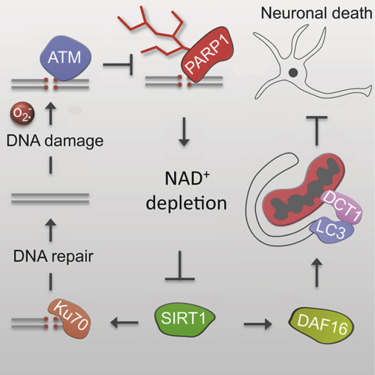

Highlights
•Mitochondrial dysfunction and defective mitophagy shown in A-T animal models
•A-T laboratory animal models exhibit NAD+ depletion and impaired SIRT1 activity
•NAD+ replenishment improves lifespan and healthspan in ATM− worms and mice
•NAD+ ameliorates A-T phenotypes through upregulation of mitophagy and DNA repair
Summary
Ataxia telangiectasia (A-T) is a rare autosomal recessive disease characterized by progressive neurodegeneration and cerebellar ataxia. A-T is causally linked to defects in ATM, a master regulator of the response to and repair of DNA double-strand breaks. The molecular basis of cerebellar atrophy and neurodegeneration in A-T patients is unclear. Here we report and examine the significance of increased PARylation, low NAD+, and mitochondrial dysfunction in ATM-deficient neurons, mice, and worms. Treatments that replenish intracellular NAD+ reduce the severity of A-T neuropathology, normalize neuromuscular function, delay memory loss, and extend lifespan in both animal models. Mechanistically, treatments that increase intracellular NAD+ also stimulate neuronal DNA repair and improve mitochondrial quality via mitophagy. This work links two major theories on aging, DNA damage accumulation, and mitochondrial dysfunction through nuclear DNA damage-induced nuclear-mitochondrial signaling, and demonstrates that they are important pathophysiological determinants in premature aging of A-T, pointing to therapeutic interventions.
